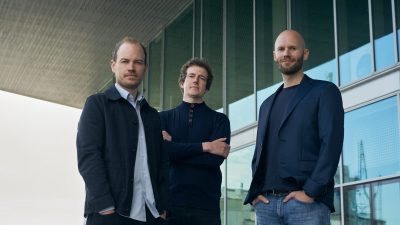
#6 Silicon Valley Going Green – Digital Technologies: a Key to the Green Transition
A key to fighting today’s climate problems is tomorrow’s innovation. This week’s ‘Going Green’ article provides an overview of some of the major technological developments that are happening today – and expected to happen in the future – and how they are working to fight against climate change.
Silicon Valley is considered the most innovative tech hub in the world, well-known for its innovative companies developing new emerging tech solutions focused on communication and digital technology advancement. A multitude of these solutions have gradually moved into our homes and lives: The robotic vacuum cleaner, the chat-bot, the voice assistant, the curated news, the smart watches, the transportation platforms. But these new data-driven technologies have the potential to do more than counting your steps and cleaning your floor.
CASE: AI can reduce the energy consumption of buildings
To reach our climate goals, we need to reduce energy consumption, and for this, AI can be a helpful tool. AI can analyse the data of weather forecasts, building occupancy, and other environmental conditions and adjust the heating, cooling, ventilation and lighting needs in an indoor space accordingly. An interesting use case comes from Google, which has given a self-taught AI algorithm control to adjust the cooling system of several of its largest data centres, leading to energy savings of around 40 percent. This large deployment of autonomous AI demonstrates the potential for artificial intelligence to manage infrastructure.
In recent years, data in large volumes has become readily accessible through new sensor technologies, satellite data and drones, making the data collection quick and inexpensive. This opens new opportunities to utilize technologies like artificial Intelligence (AI), machine learning (ML) and blockchain in combination with drones, high-speed internet and more to identify and accelerate climate solutions. Such technologies can help measure, understand, evaluate challenges and make forecasts, enabling decision makers to make informed policy choices, while also enabling the automation of responses, optimizing the use of resources and providing the smart and coupled infrastructure for responses at scale. Digital technologies can also drive behavioural change, enabling individuals to understand their carbon footprint and act to reduce it.
CASE: Fire-fighter drones can help prevent fires
The past years California has been hit by increasingly extreme fire seasons, destroying thousands of homes—the sad record of 2020 was a total burned area of about 40% of Denmark’s size. Maybe drones can help tackle future forest fires. The drones from Palo Alto-based start-up Rain Industries makes it possible to detect wildfires early and slow down the spread, by dropping balls full of retardant. They are now testing autonomous aircraft resembling small helicopters that are supposed to fly pre-emptively during potentially hazardous wildfire conditions, using their infrared sensors to locate and combat flames when they first erupt.
According to a study conducted by a group of researchers, AI is estimated to have the potential to enable the fulfilment of 93% of the environmentally Sustainable Development Goals targets.
Tackling Climate Change With Machine Learning:
A recent study by researchers at leading AI institutions such as Stanford University, Google AI and Microsoft Research has identified 13 industries where ML could have a significant impact:
- Electricity systems
- Transportation
- Buildings and cities
- Industry
- Farms and forests
- CO2 removal
- Climate prediction
- Societal impacts
- Solar geo-engineering
- Individual action
- Collective decisions
- Education
- Finance
CASE: Mapping and protecting wildlife can prevent extinction
A UN global assessment found that we are at risk of losing one million species to extinction, many of which may disappear within the next decade, partly due to climate change. To better protect wildlife, seven organizations, led by Conservation International and Google, have mapped more than 4.5 million animals in the wild using photos taken from motion-activated cameras known as camera traps. The photos are all part of Wildlife Insights, an AI-enabled, Google Cloud-based platform that streamlines conservation monitoring by speeding up camera trap photo analysis.
An Ecosystem in Support of Climate Tech Solutions
New innovative start-ups are demonstrating how new emerging tech can play an important role in mitigating and adapting to climate change, such as increased energy efficiency in consumer goods and industry, climate predictions or material optimization. Silicon Valley’s thriving ecosystem of academic institutions, venture capital, entrepreneurs and innovative corporations has a unique capacity to accelerate this innovation.
CASE: Blockchain technology can create food transparency
The company Ripe.io is using blockchain technology, IoT, AI and machine learning to create a platform where clients can track and trace their food through the food supply chain process. In the food industry, many food suppliers and producers have internal mechanisms to verify quality, taste and food safety, but no way to share that information with the rest of their supply chain. By using blockchain technology, you can share this data with all of the participants in the blockchain, thereby creating a transparent food supply chain.
Tech Companies Supporting Tech Solutions for Climate Change
Google hosts the Google AI Impact Challenge – an open call for projects on how to use AI to solve social and climate related challenges. The program has provided twenty organizations with a total of 25 million USD in grant funding from Google.org, coaching from Google’s AI experts, credit, consulting from Google Cloud and inclusion in a six-month Google Developers Launchpad Accelerator. Microsoft launched the Microsoft AI for Earth program, which awards grants and support to researchers and innovators dedicated to solving environmental challenges using cutting-edge technology. The program will award 50 million USD over its five-year span, and more than 200 research grants have already been awarded. The call is ongoing and also open to Danish academic institutions, organizations and companies. You can read more about the program here.
CASE: Automated drones and deep learning can predict maintenance needs
Current inspection methods for large structures are slow, expensive, and dangerous—just picture workers climbing ropes and scaffolding. As a solution to this, the company Prenav is leveraging drones, LiDAR, 3D analytics and deep learning to automatically identify critical damage in structures. Their technology has been used to inspect bridges, dams and cell towers, and they also completed the first-ever automated flights inside a functional nuclear reactor.
CASE: AI can make carbon markets more transparent
Carbon markets and forest management are key to achieving negative emissions. However, there is a need for transparency to make such marketplaces reliable, and this is where AI comes into the picture. One of the leading start-ups, Pachama, has developed a carbon credit marketplace where companies can support carbon offset projects. Moreover, in order to create trust in these projects, they are using satellite imagery and AI to measure carbon captured in the forests, presenting verifiable results to the purchasers of carbon credits. The company has just announced new funding from Breakthrough Energy Ventures, Amazon Climate Pledge Fund and many others.
The efficient ecosystem in Silicon Valley has already helped many companies taking off, and other new start-ups are on the rise. Below you can read about a few of the exciting solutions being developed in California that could help reduce carbon emissions for a broad range of industries.
The Downside of High Tech: Its High Energy Usage
While some high-tech solutions have the potential to reduce carbon emissions and help protect the environment, there is also a downside. The computational requirement for deep learning has proven to have a large carbon footprint. AI and machine learning work with enormous datasets, which can themselves have a significant climate impact. Some estimates suggest that the total electricity demand of information and communication technologies (ICTs) could require up to 20% of the global electricity demand by 2030, up from 1% today. Or, to put it into perspective, training one AI model could produce as much carbon dioxide as 150 round-trip flights between San Francisco and Copenhagen. Digital technologies are no panacea for all climate ills, and there is a need to consider climate tech solutions based on their lifetime impact, in order to create truly sustainable solutions. Understanding the impact of AI solutions and developing better implementation models will be an important part of the process.
CASE: Sensors help us navigate air quality
The wildfires of 2020 brought orange skies all over the San Francisco Bay Area, a scary reminder of the basic need for clean, breathable air. The start-up Aclima has introduced an entirely new way to measure air pollution and greenhouse gases, at the resolution needed to target emissions reductions and protect human health. Aclima develops a hyperlocal air quality and greenhouse gas measurement and analysis, giving everyone access to local and instant data from block to block. The Bay Area Air Quality Management District is working with Aclima to assess and analyse block-by-block measurements of air quality and greenhouse gases across all nine counties and 5,000 square miles of the San Francisco Bay Area, measured by low-emission cars equipped with air-sensing devices.
CASE: Data-driven climate decisions will be more effective
Analysing carbon emissions from a company’s energy consumption and company travel can be time-consuming. However, it is a key part of starting to make impactful changes to minimize the company’s emissions. Salesforce Sustainability Cloud is a good example of a platform that helps companies track, analyse and report environmental data to help reduce their carbon emissions and drive sustainability. The platform collects data and quantifies the company’s carbon footprint, supporting the change management through climate action plans.
Making AI and Machine Learning Models Energy Efficient
Example: Silicon Valley startup Cerebras claims to have built the largest computer chip ever to accelerate AI training. Linking processing parts in one large unit can, if successful, limit the power use normally associated with shifting data between tiny AI chips.
Silicon Valley has a knack for problem solving and an ethos of creating impact. With climate change, there are an abundance of challenges to meet, and digital technologies can and will play a central role in the integrated energy systems of tomorrow, as well as in the development of data-driven climate solutions, monitoring systems, models for behavioral change and much more. At Innovation Centre Denmark Silicon Valley, we stay up to date on the newest research and technologies and can assist in identifying technologies relevant for your company, organization or product.
CASE: Virtual reality can get people involved in climate change
Technology can also be used to engage people in the green transition. The San Francisco-based company Condition One produces virtual reality films that take viewers to the front lines of climate change in the series, “This is Climate Change”. The series demonstrates the catastrophic effects of global warming and hopes to engage the audience in driving global change.
This article was written by The Innovation Centre Denmark in Silicon Valley and is brought to you as a part of the ‘Silicon Valley Going Green’ series in collaboration with the Innovation Centre.












Comments